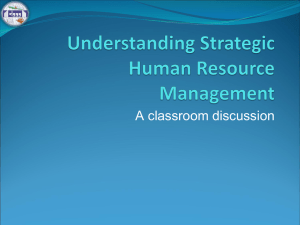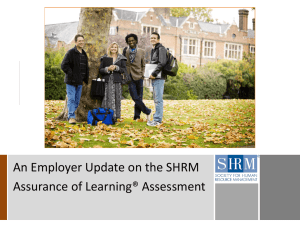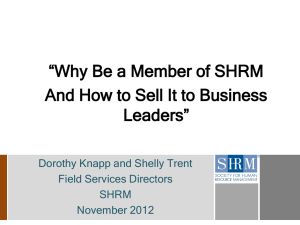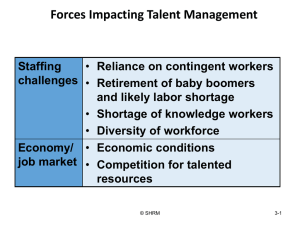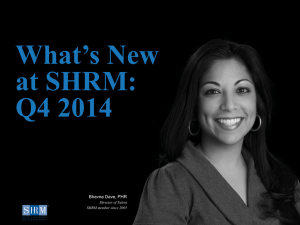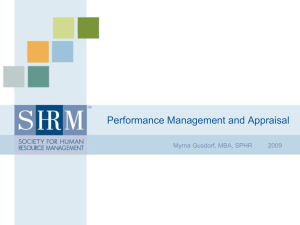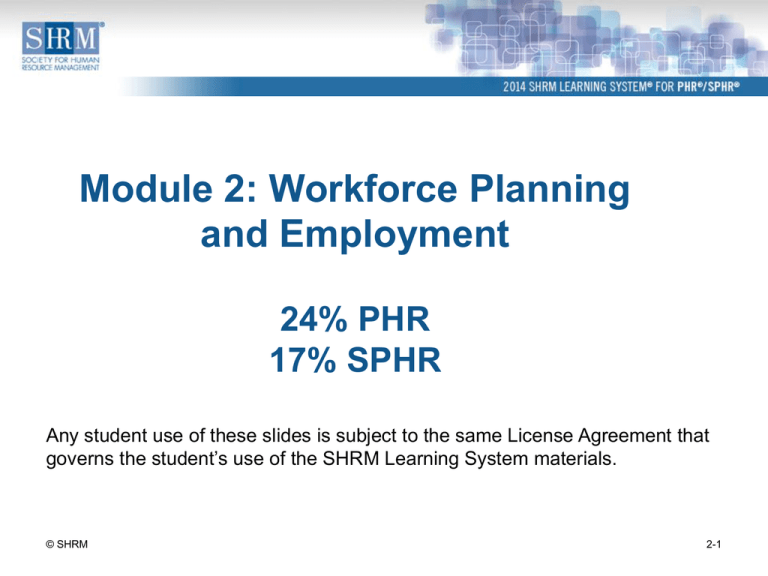
Module 2: Workforce Planning
and Employment
24% PHR
17% SPHR
Any student use of these slides is subject to the same License Agreement that
governs the student’s use of the SHRM Learning System materials.
© SHRM
2-1
Title VII of the Civil Rights Act (1964)
Title VII of the Civil Rights Act (1964)
Religion
Color
Race
Sex
Illegal to
discriminate
in
employment
National
origin
10 federally protected “classes”
© SHRM
2-2
Terminology
Sex
• Classification of people as male or female
• Biological and physiological characteristics that
define men and women
Gender
• Socially constructed roles, behaviors, activities,
and attributes that a given society considers
appropriate for men and women
• Also, the perception by others of a person’s
appearance, behavior, or physical characteristics
Transgender
• If birth-assigned sex and internal sense of gender
identity do not match
• Tendencies to vary from culturally conventional
gender roles
National
origin
© SHRM
• Country of one’s birth or of one's ancestors' birth—
even those that no longer exist
• May be interchanged with “ethnicity,” although an
“ethnic group” can refer to religion or color as well
as country of one’s ancestry
2-3
Discrimination
National Origin
• Because of
individual’s, or
his/her
ancestor’s,
place of origin
or because
individual has
physical,
cultural, or
linguistic
characteristics
of a national
origin group
© SHRM
Race
Color
• Because
individual is of
a certain race or
because of
personal
characteristics
associated with
race
• Because of skin
color
2-4
General Provisions of Title VII
Prohibits discrimination against protected classes.
Makes it unlawful to deny employment opportunities,
training, or career advancement to protected classes.
As amended, prohibits discrimination because of
pregnancy, childbirth, or related conditions.
Prohibits sexual harassment.
Prohibits compensation discrimination.
© SHRM
2-5
Which of the following organizations would
be subject to the EEOC rules and regulations
specified in Title VII and its amendments?
A. A five-person, family-owned computer repair
business
B. An independent college with 80 employees
C. A franchise operation with two full-time
managers and ten part-time employees
D. A new labor union with 14 members
Answer: B
© SHRM
2-6
Title VII Exceptions
Several exceptions to the definition of
discrimination exist, including:
Work-related requirements
BFOQs
Bona fide seniority systems
Affirmative action plans
© SHRM
2-7
Civil Rights Act (1991)
• Allows jury trials when a plaintiff seeks
compensatory or punitive damages.
• Compensatory damages are awarded to make
an injured person “whole.”
• Under federal law, punitive damages are not
possible against a governmental unit or agency.
• Amount of compensatory and punitive damages
is based on the size of the employer’s workforce.
Related case: Kolstad v. American Dental Association
© SHRM
2-8
Compensatory and Punitive Damages
Maximum Recovery
per Individual
Number of
Employees
$50,000
15–100
$100,000
101–200
$200,000
201–500
$300,000
501 or more
The maximum recovery amount is for a total
of compensatory and punitive damages.
© SHRM
2-9
Age Discrimination in Employment
Act (1967)
ADEA prohibits:
ADEA covers:
Employment discrimination
against persons age 40 and over.
Employers with 20 or more
employees.
Mandatory retirement based on
age.
Unions with 25 or more
members.
Limiting employee status due to
age.
Employment agencies and
apprenticeship programs.
© SHRM
2-10
ADEA Exceptions
• Age can be a BFOQ if necessary for the normal
operation of the business.
• Exceptions can occur when:
The organization
has a genuine
seniority or
benefit plan.
The employer
disciplines or
fires for good
cause.
The employee is
a top executive
or policy maker.
© SHRM
2-11
Pregnancy Discrimination Act (1978)
An organization:
• May not refuse to hire or fire a woman
simply because she is pregnant.
• May not force a pregnant employee to
leave if she is ready, willing, and able to
work.
• Must treat pregnancy the same as any
other temporary disability.
© SHRM
2-12
Americans with Disabilities Act
(1990)
Prohibits discrimination against qualified
individuals with disabilities.
Requires reasonable accommodation unless the
employer can show undue hardship.
Applies to employers with 15 or more employees,
employment agencies, labor organizations, and
joint labor-management committees.
© SHRM
2-13
ADA Terms
Disability
• Has an impairment that substantially limits
one or more major life activities
• Has a record of such an impairment
• Is regarded as having such an impairment
Essential functions
• Primary job duties that an individual must be
able to perform, with or without
accommodation
© SHRM
2-14
ADA Amendments Act (ADAAA)
• Retains the basic definition of disability contained in
the ADA but expands interpretation.
• Makes it easier to meet the definition of “disability.”
• Includes nine rules of construction.
• Identifies several impairments that virtually always
meet the definition of disability.
• Expands the ADA list of major life activities.
© SHRM
2-15
Which of the following are the only mitigating
measures allowed by the ADAAA when
assessing whether an impairment
substantially limits a major life activity?
A. Medications
B. Implantable hearing devices
C. Ordinary eyeglasses or contact lenses
D. Prosthetic devices
Answer: C
© SHRM
2-16
Reasonable Accommodation
Modifying or adjusting a job application
process, a work environment, or the
circumstances under which a job is
usually performed
Examples
• A reader to help an applicant who is visually impaired
• Construction to provide accessibility
• Alternative formats for employee training
• A telephone device for a person who is hearing-impaired
• Alternate work schedules
© SHRM
2-17
Direct Threat Standard
• Employers can establish qualification standards that
exclude individuals who pose direct threat (significant risk
of substantial harm) to health or safety of individual
himself or herself or others if that risk cannot be
eliminated or reduced below level of “direct threat” by
reasonable accommodation.
• However, employer may not simply assume that threat
exists; employer must establish through objective,
medically supportable methods that there is significant
risk that substantial harm could occur in workplace.
© SHRM
2-18
Genetic Information
Nondiscrimination Act (2008)
• Prohibits discrimination against an individual
in hiring, firing, compensation, or terms or
privileges of employment on the basis of
genetic information about the individual or a
family member.
• With limited exceptions, prohibits an employer
from requesting, requiring, or purchasing
genetic information on the individual or a
family member.
© SHRM
2-19
Lilly Ledbetter Fair Pay Act (2009)
• Creates a rolling or open time frame for filing
wage discrimination claims.
– Retains the 180-/300-day time frame outlined
in Title VII.
– Restarts the statute of limitations each time an
employee receives a paycheck based on the
decision.
• Expands the plaintiff field.
Related case: Ledbetter v. Goodyear Tire & Rubber Co.
© SHRM
2-20
Uniform Guidelines on Employee
Selection Procedures (1978)
Covers all aspects of the selection process.
Prohibits selection procedures that have adverse
impact on protected groups.
Adverse impact occurs when the rate for a protected
group is less than 80% of the rate for the group with
the highest selection rate (also known as the 80% rule
or four-fifths rule).
© SHRM
2-21
An organization interviews 60 males and
40 females. They hire 30 males and 10
females. What is the selection rate of
females?
A. 25%
B. 30%
C. 40%
D. 50%
Answer: A
© SHRM
2-22
Is there adverse impact?
Group
Males
Females
Number
Interviewed
60
40
Number
Hired
30
10
Percentage
Hired
50%
25%
Answer:
Yes.
Here is the calculation:
50% of the males were hired. To determine adverse impact,
multiply 4/5 or 80% 50% = 40%.
Adverse impact occurred because 25% of the females
were hired, not the required threshold of 40%.
© SHRM
2-23
Affirmative Action Obligations
• Federal laws that apply to federal government
contractors and impose AA obligations include:
– Executive Order 11246.
– Vietnam Era Veterans Readjustment Assistance Act
and Jobs for Veterans Act.
– Section 503 of the Rehabilitation Act.
• Legal obligations on employers depend on:
– Value of the federal contracts/subcontracts.
– Number of employees.
© SHRM
2-24
Rehabilitation Act (1973)
Prohibits discrimination based on physical
or mental disabilities.
Section 501 applies only to the federal
government as an employer; Section 503
applies to federal contractors and
subcontractors with contracts over $10,000.
Requires employers to take affirmative
action and make reasonable
accommodation.
© SHRM
2-25
Immigration and Nationality Act
(1952)
Fundamental body of U.S. immigration law
applying to all employers.
• Defines “alien” as any person lacking citizenship or
status as a national of the United States.
• Differentiates aliens as:
– Resident and nonresident.
– Immigrant and nonimmigrant.
– Documented and undocumented.
© SHRM
2-26
Immigration Reform and Control Act
(1986)
Prohibits
discrimination on
the basis of
national origin or
citizenship.
Establishes
penalties for hiring
illegal aliens.
Places burden on
employers to verify
All documents must
an employee’s
be unexpired.
identity and right to
work.
© SHRM
2-27
Which document would prove identity
and right to work in the U.S.?
A.
B.
C.
D.
U.S. military ID card
Social Security card
Driver’s license with photo
Permanent Resident Card
Answer: D
© SHRM
2-28
E-Verify
Accesses an Internet-based verification system operated
by the USCIS in partnership with the Social Security
Administration.
Electronically checks the information provided by the
employee on his or her Form I-9 against records
contained in Department of Homeland Security and Social
Security Administration databases.
Participation is voluntary for most businesses but may be
required by state law or federal regulations.
© SHRM
2-29
Visa Categories
Immigrant visas
(green cards) are
permanent.
• Divided into three
preference groups
based on their
importance and the
number allocated to
each group annually
(EB-1, EB-2, EB-3).
© SHRM
Nonimmigrant visas
are temporary.
• H-1B is reserved for
professionals who
come to the U.S. for
a limited amount of
time.
• There is a yearly
cap on the number
of H-1B visas.
2-30
WARN Act (1988)
Worker Adjustment and Retraining Notification
(WARN) Act
Requires a
minimum of 60
days’ notice for:
• Plant closings.
• Mass layoffs.
Limited exceptions:
faltering company,
unforeseeable business
circumstances, natural
disaster
© SHRM
States that notice be
given to:
• Affected workers or
their
representatives.
• State dislocated
worker units.
• Local government.
2-31
EEOC Complaint Process
EEO charge filed.
EEOC notifies respondent of
charge via a letter.
EEOC sends respondent a copy
of the charge.
EEOC reviews charge and
assesses "reasonable cause."
If reasonable cause is found . . .
© SHRM
If the EEOC does not make a
determination . . .
• EEOC attempts conciliation.
• Respondent required to
provide remedies to settle.
Charging party has right to
request right-to-sue letter after
180 days.
Charge is settled or may go to
litigation with EEOC or private
court.
Charging party must file suit in
court within 90 days.
If reasonable cause is not found . . .
• EEOC notifies both parties.
• Charging party is notified of
right to sue.
• EEOC involvement ends.
Charging party may file suit in
court within 90 days.
2-32
Employee Polygraph Protection Act
(1988)
• Regulates the use of lie detectors.
• Allows the use of lie detector tests when:
– The employer is the federal, state, or local
government.
– Prospective employees will work in security-sensitive,
drug manufacturing, or intelligence situations.
– Current employees are under reasonable suspicion
of involvement in workplace incident that results in
economic loss.
• Employer may not discharge an employee
based solely on test results or refusal to test.
© SHRM
2-33
Consumer Credit Protection Act
(1968)
Limits the amount of wages that can be garnished or
withheld in any one week to satisfy creditors (generally
25% of disposable pay).
Prohibits employers from terminating an employee for
one single indebtedness.
Garnishment restrictions do not apply to certain
bankruptcy court orders or debts due for federal or state
taxes.
© SHRM
2-32
Fair Credit Reporting Act (1970)
• Applicant/employee must provide written
authorization before a consumer report is
ordered.
• Employer must provide:
• Written notice that a report may be used and time for a
response to the report.
• Notice that an adverse action has been taken (must
be provided within three days of the action).
• A written response (within five days) to a request
for complete disclosure.
© SHRM
2-35
Fair and Accurate Credit
Transactions Act
• Provides relief to employers using third parties for
workplace investigations.
• Amends the FCRA by eliminating the consent and
disclosure requirements when a third party
conducts an investigation involving:
– Suspected misconduct.
– A violation of law or regulations.
– A violation of any preexisting written policies of the
employer.
• Includes directives aimed at uncovering and
preventing incidents of identity theft.
© SHRM
2-36
Amendment to FCRA by
Dodd-Frank Act
If any adverse action is taken against an applicant or employee,
either partly or wholly because of information contained in a
consumer report, additional notification requirements include:
The individual’s credit score that was used.
The range of credit scores possible under the credit scoring
model used.
Each of the factors that adversely affected the individual’s
credit score.
The date the score was created.
The name of the consumer reporting agency or person that
furnished the credit score.
© SHRM
2-37
Equal Employment Opportunity
• The term “protected classes” refers to people who
are covered under a federal or state
antidiscrimination law.
• Laws require employment decisions to be job- and
business-related and not made on the basis of:
–
–
–
–
–
–
© SHRM
Race.
Sex.
Ethnicity.
Religion.
Age.
Color.
–
–
–
–
Military/veteran status.
Genetic information.
FMLA entitlement.
Disability.
2-38
Types of Discrimination
Disparate treatment
• Treating protected classes differently than other
employees or evaluating them by different standards.
Adverse or disparate impact
• Applying rules that have a negative effect on
protected classes to all employees.
Perpetuating past discrimination
• Using employee referral programs that maintain racial
inequity.
© SHRM
2-39
Griggs v. Duke Power
• Landmark case that recognized adverse impact
discrimination.
• Established that employment discrimination
need not be overt or intentional.
• Found that employment practices can be illegal
even when applied to all employees.
• Places burden on the employer to prove that
requirements are job-related.
© SHRM
2-40
McDonnell Douglas Corp. v. Green
• Landmark case that established criteria for
disparate treatment.
• Ruled that a prima facie case can be shown if
an employee:
– Belongs to a protected class.
– Applied for a job when the employer sought
applicants.
– Was qualified and yet was rejected.
– Was rejected but the employer kept looking.
© SHRM
2-41
Other Key Cases
• Albemarle Paper v.
Moody
– Any test used for
promotion/selection
must be a valid
predictor for job
success.
• Washington v. Davis
– Disproportionate impact
of a test does not
warrant conclusion that
it is purposely
discriminatory.
© SHRM
• St. Mary’s Honor Center v.
Hicks
– An employee must prove
that an employer’s
reason for an adverse
action is based on a lie
and that the lie was to
cover up discrimination.
• McKennon v. Nashville
Banner Publishing Co.
– After-acquired evidence
cannot free an employer
from discrimination
liability.
2-42
EEO Reporting
• Annual reporting is required for:
– Employers with 100 or more employees.
– Federal contractors with at least 50 employees
and contract of $50,000.
• Posters and officially approved notices must be
put in prominent locations where they can be
seen by employees.
© SHRM
2-43
The EEO-1 report requires many
employers to provide a count of their
employees by job category and then by
A.
B.
C.
D.
job title, gender, and race.
race, ethnicity, and gender.
wage rate or salary range.
total number of male and female incumbents
against placement goals.
Answer: B
© SHRM
2-44
Internet Job Applicants
• OFCCP final regulations apply to federal
government contractors/subcontractors.
• For purposes of Title VII, the EEOC
recommends that employers who are not
federal contractors or subcontractors look
to the OFCCP definition of applicant.
© SHRM
2-45
Internet Job Applicants
Final regulations require that:
• The individual expresses interest in employment
over the Internet or related electronic data
technology.
• The employer considers the individual for
employment in a particular position.
• The individual’s expression of interest indicates that
the individual possesses the basic qualifications for
the position.
• The individual does not remove himself or herself
from consideration at any point in the employment
process.
© SHRM
2-46
Applicant Flow Data
• Federal government contractors must be able to
identify, when possible, the race, gender, and
ethnicity of applicants.
• Used to evaluate differences in selection rates
among different groups to determine if there is
adverse impact.
• Is obtained by:
– The use of paper or electronic self-identification form
(preferable).
– A visual survey of applicants.
© SHRM
2-47
Affirmative Action
Employers:
• Make efforts to
increase presence of
women, minorities,
covered veterans, and
disabled individuals in
workplace.
• Take positive steps to
correct their
underutilization.
© SHRM
2-48
Major Elements of AAP
Organizational
profile
• Depicts staffing patterns to
determine if barriers to equal
employment opportunity exist.
Organizational
display
• Provides a graphical
representation of the
organizational units.
© SHRM
Workforce
analysis
• Lists job titles ranked from lowestto highest-paid within an
organizational unit.
Job group
analysis
• Lists all job titles in each job group
and shows jobs by functional (not
departmental) alignment.
2-49
Availability Analysis
• Requires that organizations consider internal and
external availability to determine the theoretical
availability of women and minorities.
– Organization compares the percentages of women
and minorities in each group with the theoretical
availability.
– A variety of statistical methods can be used for
calculating the comparison: “any difference rule,”
“80% rule” (“four-fifths rule”), “two standard deviations
analysis.”
– Placement goals are set when the percentage of
minorities or women is less than reasonably expected
given their availability percentage.
© SHRM
2-50
Which of the following is frequently a
trigger for an AA audit by the OFCCP?
A.
B.
C.
D.
A surge of workers’ compensation claims
Membership in a technology-based industry
A mass layoff of management employees
A federal contract of over $10 million
Answer: D
© SHRM
2-51
Types of Audits
Audits
Compliance
review
© SHRM
Compliance
check
Focused
review
Off-site
review
2-52
Corporate Management Compliance
Evaluations and the Glass Ceiling
Purpose
Focus
Designed to ensure that
qualified minorities,
women, persons with
disabilities, and protected
veterans do not encounter
artificial barriers to future
advancement into midlevel and senior corporate
management.
Focuses on a contractor’s
obligation to make goodfaith efforts to ensure that
equal employment
opportunity extends to all
levels of the workforce.
© SHRM
2-53
Fairness Issues
Reverse
discrimination
© SHRM
• Courts allow
temporary
preference to
protected classes.
Quotas vs.
placement goals
and merit hiring
• Generally not
allowed by the
courts.
Bona fide
occupational
qualification
• Carefully
scrutinized by
courts.
2-54
Employment Practices Liability
Insurance
• EPLI covers businesses against claims by workers that
their employee rights have been violated.
• Policies cover legal costs whether the company wins or
loses.
• Policies usually do not cover:
– Punitive damages or civil and criminal penalties.
– Liabilities covered by other insurance such as workers’
compensation.
• Employer may have a duty to notify the carrier upon
receipt of a letter from a lawyer, even if no claim has
been filed. If not done, coverage could be waived.
© SHRM
2-55
Sexual Harassment
Quid pro quo
Hostile
environment
Employee must
give in to sexual
demands or
forfeit an
economic
benefit (job or
raise).
Sexual or
discriminatory
conduct creates
a threatening or
abusive work
environment.
© SHRM
2-56
Sexual Harassment Cases
Meritor Savings Bank
v. Vinson
Harris v. Forklift
Systems, Inc.
Oncale v. Sundowner
Offshore Service, Inc.
Faragher v. City of
Boca Raton and
Ellerth v. Burlington
Northern Industries
© SHRM
• Held that sexual harassment violates
Title VII.
• Established “reasonable person”
standard.
• Same-gender harassment is
actionable.
• Held employers liable for supervisory
harassment that resulted in adverse
employment action.
2-57
Vicarious Liability
Employers are liable for discriminatory
actions by their employees.
Employers must end harassment through
intervention or discipline.
Employees should utilize preventive and
corrective action opportunities.
© SHRM
2-58
Harassment Policy/Prevention
Have a written policy with a clear definition of
harassment and a statement that it will not be
tolerated.
Establish a complaint procedure.
Provide training and education.
Investigate every complaint.
Discipline if necessary.
Communicate via variety of methods to
management and employees.
© SHRM
2-59
Workforce Planning
Staffing
• Provides qualified
individuals for jobs in the
organization.
• Addresses current and
future needs for
knowledge, skills, and
abilities.
© SHRM
Workforce Planning
• Analyzes organizational
workforce and prepares
for future needs.
• Forecasts future
conditions and identifies
gaps between current
and future staff.
2-60
Workforce Analysis Process
Supply Analysis
Demand Analysis
Gap Analysis
Solution Analysis
© SHRM
2-61
Trend Analysis
Determines the relationship between two
variables.
1
Business
Factor
(sales in
millions)
$3.613
2
$3.748
$11,120
337
3
$3.880
$12,520
310
4
$4.095
$12,520
327
5
$4.283
$12,520
342
6
$4.446
$12,520
355
Year
© SHRM
Labor Productivity
(annual sales per
employee)
HR Demand
(number of
employees)
$11,120
325
2-62
Trend Analysis
Plots the number of employees for the last six
years and projects the trend out for two more
years.
380
370
360
Number of
Employees
350
340
330
320
310
1
2
3
4
5
6
7
8
Years
© SHRM
2-63
Turnover Analysis
• Most often expressed using an annualized
formula.
• Calculated by dividing the number of separations
per year by the average number of employees
per month.
• 65 separations per year ÷ 225 average
employees per month = 28.9% turnover.
• May also be calculated quarterly and used to
project the annual turnover.
© SHRM
2-64
Flow Analysis
Projects future movement.
Inflow
© SHRM
Outflow
Current
Staff
Transfers
Promotions
New hires
Recalls
5
4
15
10
Promotions
5
Resignations 13
Demotions
0
Retirements
4
Terminations 3
Layoffs
15
Total
34
Total
40
2-65
Demand Analysis Techniques
Project the number of employees and the types
of skills needed for the future.
Judgmental
forecasts
Statistical
forecasts
© SHRM
• Managerial estimates
• Delphi technique
• Nominal group technique
• Regression analysis
• Simulations
2-66
Organizational and Staffing
Approaches to International Business
SPHR only
Four terms describe how a firm manages
its international operations.
Ethnocentric
© SHRM
Polycentric
Regiocentric Geocentric
2-67
Types of International Workers
SPHR only
• Short-term assignees
• Long-term assignees
• Sequential/rotational
employees
• Commuting employees
(international commuters)
• Frequent flyers/extended
business travelers
Ethnocentric
Polycentric
• Stealth expats/stealth
pats/stealth assignees
• Local hires (local nationals)
• Localized employees
© SHRM
• Permanent assignees
(permanent locals)
• Interns/trainees (temporary,
nonimmigrants)
• Returnees
• Virtual employees
• Retirees
• Part-time employees
Geocentric
• Temporary (contingent)
employees
• Temp-to-hire (temp-to-permanent)
employees
• Outsourced employees
2-68
Job Analysis and Employee Jobs
Job
analysis
Job description
Job specifications
Employee
role/job
Job competencies
© SHRM
2-69
Job Analysis
Knowledge
• Information necessary for task performance
Skills
• Level of proficiency needed for task
performance
Abilities
• Capabilities necessary to perform job
© SHRM
2-70
Job Analysis Methods
Observation
Interview
Open-ended questionnaire
Highly structured questionnaire
Work diary or log
© SHRM
2-71
Job Analysis Uses
Organizational design
Legal defense
· ADA
· Termination
· Workers’ compensation
Affirmative action plan
Recruiting and selection
Job
analysis
Time management/
goal setting
Training
Establishing career
paths/succession
planning
© SHRM
Compensation
administration
Establishing
performance standards/
performance appraisals
2-72
Job Descriptions
Summarize the most important features of a
job.
Detail the required tasks, KSAs,
responsibilities, and reporting structure.
Include the physical requirements of the job
for ADA considerations.
Include duties that support exempt status.
© SHRM
2-73
Which of the following would MOST
likely be an essential job function?
A. Devotes approximately 8% of time to direct
customer contact
B. Regularly reviews engineering design documents
C. As time permits, participates in an ongoing
employee committee assignment
D. May delegate template preparation to
administrative support
Answer: B
© SHRM
2-74
Job Specifications
Qualifications necessary for an incumbent to be able
to perform the job.
Includes experience, training, education, licenses,
and certification required; physical and mental
demands; level of organizational responsibility.
Can be a separate section of the job description or a
separate document.
Should reflect what is necessary for satisfactory
performance, not what the ideal candidate should
have.
© SHRM
2-75
Job Competencies
Job competencies are the knowledge, skills, abilities,
and personal characteristics that work together to allow
an employee to produce outstanding performance.
They are the critical success factors needed to perform
in a job or functional area.
Core competencies are aligned with key business
objectives and/or values and contribute to
organizational success.
© SHRM
2-76
The FIRST step in determining which
candidates are qualified for an open
position is a(n)
A. review of the job description.
B. assessment of the organization’s ability to
pay.
C. review of the candidates’ résumés.
D. evaluation of internal candidates.
Answer: A
© SHRM
2-77
Internal Recruitment Sources
© SHRM
Job
posting
Job
bidding
Skill banks
and skill
tracking
systems
Employee
referrals
2-78
External Recruitment Sources
Former employees
Nontraditional labor
pools
Previous applicants
Labor unions
Minority recruiting
Several
Possibilities
School-to-work
programs
Walk-ins
Educational recruiting
Media advertising
© SHRM
Trade and professional
associations
The Internet
Third-party
sources
Social media
2-79
Employment Branding
• Positions the organization as an
“employer of choice” in the labor market.
• Must be aligned with strategic plan,
vision, mission, and values.
• Uses the same tools used to market the
product to create an image of what it is
like to work for the organization.
© SHRM
2-80
Recruitment Effectiveness
Short-term
• Time to recruit applicants
• Selection and
acceptance rates
• Cost per applicant hired
• Quantity and quality of
applicants
• EEO implications
© SHRM
Long-term
•
•
•
•
Performance of hires
Turnover
Absenteeism per hire
Training costs
2-81
Cost per Hire
(External costs) + (Internal costs)
Cost per hire (CPH) =
Total number of hires in a time period
© SHRM
2-82
Recruitment Cost and Yield Ratios
Recruitment cost ratio (RCR)
External costs + Internal costs
100
Total first-year compensation of hires in a time period
$200,000
100 = 10%
$2,000,000
Yield ratios
Qualified applicants 100
= 33%
Total applicants
300
Offers extended
5
= 33%
Qualified applicants 15
Minority applicants 80
= 27%
Total applicants
300
Offers extended
Final interviews
Female applicants 185
= 62%
Total applicants 300
Offers accepted 3
= 60%
Offers extended 5
© SHRM
5
= 50%
10
2-83
An organization made 30 offers, and 18
were accepted. What is the yield ratio of
acceptance to offers?
A. 35%
B. 45%
C. 55%
D. 60%
Answer: D
Calculation: 18 ÷ 30 = 60%
© SHRM
2-84
Flexible Staffing
• Uses alternative recruiting sources and
workers who are not regular employees.
• The choice of arrangement depends on:
– Function.
– Level of supervision required.
– Time constraints.
– Financial constraints.
– Legal risks and liability.
© SHRM
2-85
Co-Employment
• Organization and alternative staffing
supplier share joint responsibility for
alternative workers.
• Agreement summarizes:
– Legal relationship.
– Rights and obligations.
• Potential liability varies depending on the
nature of the agreement.
© SHRM
2-86
Selection Process
Selection
Step 1: Analyzing application forms
Step 2: Interviewing
Step 3: Testing and background
investigation
Step 4: Contingent job offer
Step 5:
Employment
offer
© SHRM
2-87
Step 1: Analyzing Application Forms
Types of forms:
• Short forms
• Long forms
• Targeted
application forms
• Weighted
application forms
• Résumés
© SHRM
Uses:
• Serve as a
prescreening
device.
• Collect job-related,
nondiscriminatory
data.
• Call attention to red
flags.
2-88
Step 2: Interviewing
Step 2: Interviewing
Types of Interviews
In-depth
Prescreening
Most
prescreening is
done over the
telephone.
•
•
•
•
•
•
•
•
Structured
Patterned
Stress
Directive
Nondirective
Behavioral
Situational
Group
All interview questions should be job-related and nondiscriminatory.
© SHRM
2-89
Interviewer Biases
© SHRM
Stereotyping
Inconsistent
questioning
First-impression
error
Negative
emphasis
Halo/
horn effect
Nonverbal bias
Contrast effect
Similar-to-me
error
Cultural noise
2-90
An interviewer assumes that a woman
will do poorly in a job that requires math
and analytical skills. This interviewing
bias is known as
A. horn effect.
B. cultural noise.
C. stereotyping.
D. negative emphasis.
Answer: C
© SHRM
2-91
Step 3: Testing and Background
Investigation
Tests
•
•
•
•
•
•
•
•
Cognitive ability
Personality
Aptitude
Psychomotor
Assessment centers
Honesty/integrity
Polygraph
Substance abuse
© SHRM
Background Checks
• Work reference
• Verification of academic
credentials
• Credit history
• Motor vehicle
• Criminal background
2-92
Selection Reliability
• Ability to measure or predict behavior with
consistency.
– Example: Scores for a test that is taken twice should
be similar.
• The following errors may create inconsistent
results:
–
–
–
–
© SHRM
Failure to measure an important attribute
Irrelevant questions in an interview
Different time limits for people taking a test
Rater bias in evaluating candidates
2-93
Selection Validity
• Content validity
– Degree to which a test measures knowledge, skills,
and abilities that are part of the job
• Construct validity
– Degree to which a test measures a trait such as
intelligence
• Criterion-related validity
– Correlation of test results to job performance
• Predictive
• Concurrent
© SHRM
2-94
Criterion-Related Validity
Predictors
· Completed
application form
· Résumé data
· Interview answers
Criterion Variable
· Performance evaluations
· Productivity
· Absenteeism
· Test scores
The greater the overlap between predictors and
variables, the better the predictor.
Complete correlation = +1 or –1
© SHRM
2-95
Approaches to Establishing CriterionRelated Validity: Concurrent Validity
Test employees on
key attribute.
Measure employees'
job performance.
Correlate two sets of
numbers.
© SHRM
2-96
Approaches to Establishing CriterionRelated Validity: Predictive Validity
Measure all applicants
on attribute.
Hire and wait for some
time period.
Obtain correlation
between these two
numbers.
Measure performance of
newly hired employees.
© SHRM
2-97
Realistic Job Previewing
• Helps a candidate make an informed decision.
• Allows the organization to objectively portray the
job.
• Examples of job preview techniques may
include:
–
–
–
–
–
© SHRM
Workplace tours.
Interviews with job incumbents.
Job simulations.
Video or CD-ROM presentations.
Automated job telephone information line.
2-98
Step 4: Contingent Job Offer
A conditional job offer may depend on:
Additional tests.
Verification of IRCA documents.
A medical exam (if job-related and
consistent with business necessity).
© SHRM
2-99
Step 5: Employment Offer
• Formally communicated through an offer
letter.
• Clearly states terms of the offer.
• Avoids language that implies a contract
(states that employment is at will).
• Clarifies contingencies (physical exam).
• Clarifies acceptance details and deadline.
© SHRM
2-100
Employment Contracts
• Agreement between employer and
employee that explains the employment
relationship.
– Express contract is based on oral or written
words.
– Implied contract results from actions or
conduct.
• Employment-at-will is presumed if a written
employment contract does not exist.
© SHRM
2-101
Which type of employment situation
would MOST likely warrant a written
employment contract?
A. A part-time employee
B. A salesperson
C. A graphic artist
D. A department manager
Answer: B
© SHRM
2-102
Retention
The ability to keep talented
employees in the organization.
• Involves strategic actions to keep high
performers motivated and focused.
• Preserves and develops an organization’s
human capital.
• Reduces voluntary turnover costs.
© SHRM
2-103
Retention Strategies
Socialization
Onboarding
Clear and
consistent job
expectations
Clear and fair
supervision
Training and
development
Adequate
resources
Growth and
promotional
opportunities
Recognition
Respect
Perceived equity
© SHRM
2-104
Onboarding
• Encompasses orientation.
• Teaches about the employee
Informal
role in terms of task and
socialization.
• Integrates the employee into
the established organizational
Formal
culture and norms.
• Builds relationships and
creates a sense of
acceptance.
© SHRM
2-105
Succession Planning
SPHR only
Helps identify and foster the development of
high-potential employees.
Keeps talent in the pipeline.
Requires careful thought when selecting
candidates.
Necessitates well-conceived training and
development.
© SHRM
2-106
Organizational Exit
• Manages the way people
leave an organization.
• Layoffs or RIFs are based
on:
–
–
–
–
Skills.
Work record.
Seniority.
Disparate impact
implications.
– EEO/legal
considerations.
© SHRM
• Management should
document the criteria
used to make layoff
decisions.
• Separation should be
considered a termination
if there is no chance of a
recall.
• Severance packages are
not required by federal
law.
2-107
An organization is laying off 15% of its workforce
due to declining global markets. What can HR do
to help the remaining employees through the
transition?
A. Run a series of regional focus groups with mid-level
managers.
B. Publicize that exit interviews were conducted with all
separated employees.
C. Regularly communicate with employees about ongoing
business challenges.
D. Hold an organization-wide teleconference to address
rumors.
Answer: C
© SHRM
2-108
Wrongful Terminations
Constructive
discharge
Retaliatory discharge
Coercion
© SHRM
2-109
Voluntary Retirement
• Management must:
− Identify what units of the company are eligible to
participate in a voluntary program.
− Communicate that the plan is voluntary.
• The plan must comply with the Older Worker’s
Benefit Protection Act.
− Voluntary waivers or claims under ADEA are valid
only when waivers are “knowingly and voluntarily”
made.
© SHRM
2-110
The OWBPA requires that employees
signing a waiver of their ADEA rights must
A. be given at least 14 days to consider the
agreement.
B. receive severance pay or something of value.
C. consult an attorney prior to signing the waiver.
D. have at least three days to revoke the agreement
after it is signed.
Answer: B
© SHRM
2-111
Exit Interviews
• Gain candid
information from
departing employees.
• Are conducted most
often when
terminations are
voluntary.
• Are conducted by a
neutral party.
© SHRM
• Exit form may be
used to collect
information.
• Comments are
typically kept
confidential.
• Assurance may be
given that remarks
will not be shared
with a supervisor.
2-112
Records Management
Federal and state
statutes
Status as a government
contractor or
subcontractor
Requirements
may depend on …
Number of employees or
purpose of record
keeping
© SHRM
Industry, location, or
customers
2-113
Electronic Communication and
Record Keeping
• The record-keeping system must have reasonable controls to
ensure the integrity, accuracy, authenticity, and reliability of the
records kept in electronic form.
• The electronic records must be maintained in a safe and
accessible place.
• The electronic records must be able to be converted to paper
format.
• Adequate records management practices must be in place.
© SHRM
2-114

